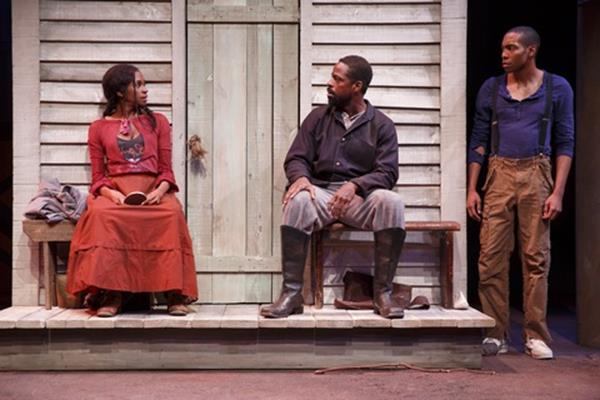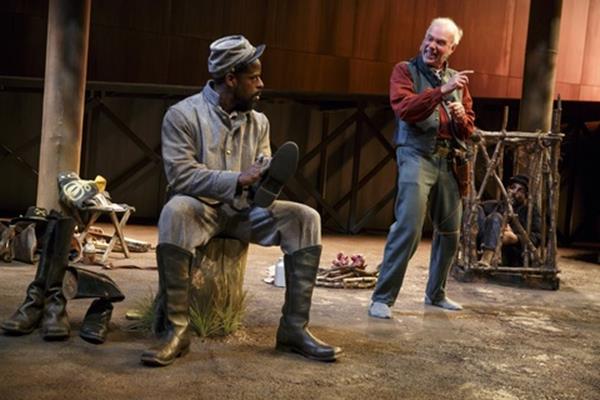Father Comes Home from the Wars (Parts 1, 2 & 3)
Suzan-Lori Parks' ambitious cycle of nine plays begins with the Civil War and its aftermath from the point of view of African American slaves in Texas.

Jenny Jules, Sterling K. Brown and Jeremie Harris in a scene from “Father Comes Home from the Wars (Parts 1, 2 & 3)” (Photo credit: Joan Marcus)
As a playwright Suzan-Lori Parks is nothing if not ambitious. This is the same writer who in 2003 wrote one play a day for one year and ended up with 365 Days/365 Plays produced in 330 theaters worldwide. Currently she is premiering the first three plays in her Father Comes Home from the Wars cycle of nine plays stretching from the Civil War South to our time at the Public Theater where the majority of her plays have had their New York debuts. The unifying theme is freedom, but along the way she deals with loyalty and betrayal, truth and lies, and identity and value. Director Jo Bonney has taken on the job of unifying the first three plays which is no small task.
While Parks’ plays have tended to be unusual in form, the new play is a vast conglomeration of many devices. The first three plays in the new cycle include a Greek Chorus, the use of mythology and history, music and songs, poetic passages, actors directly addressing the audience, a talking dog and some modern anachronisms. Parks’ models include Sophocles, O’Neill, O’Casey and Brecht. This may be more than a single evening in the theater can deal with at one time.
Underlying all of the storytelling is the archetype of Homer’s Odyssey, the story of another journey in another time of war. Many of the characters (Penny, Ulysses, Homer, Odyssey pronounced “Odd-see”) take their names from this work. What may be most unusual about this first cycle of plays is that it is one of the few stage works to tell the story of the Civil War entirely from the point of view of African American slaves.
The three plays are set in two different locations and three discrete time periods. The first part, “A
Measure of a Man” is mainly exposition covering previous events and introducing the characters. Set in early spring 1862, Hero, a slave on a plantation in Far West Texas, has been offered his freedom if he accompanies his master the Colonel to the war. However, from previous experience Hero knows he can’t trust his master. While his father and his wife Penny hope he will choose not to go, The Chorus of Less Than Desirable Slaves take bets as to his eventual decision. Hero vacillates between his own safety, his loyalty to his master and his need to be free.
The second part, “A Battle in the Wilderness,” takes place in a wooded area in the South during late summer 1862. The Colonel, who has lost his regiment, has captured a Union soldier who is a captain in the 1st Kansas Colored Infantry. This part is a series of ironic parables about freedom and a play of ideas. The captured soldier is kept in a cage while Hero, the colonel’s slave is out gathering wood unattended in order to make a fire for dinner.
The Colonel offers to free Captain Smith and give Hero to him if he can guess Hero’s price. In order to do so, the Colonel has Hero undergo the kind of inspection that we know took place on the auction block. When the Confederate Colonel goes off to scout the Union enemy who can be heard in the distance, Hero asks, “How much you think we’re gonna be worth when Freedom comes?” When the captain explains that he will belong to himself, Hero discovers to his chagrin that “the worth of a colored man, once he’s made Free, is less than his worth when he’s a slave.”
The third section, “The Union of My Confederate Parts,” returns us to the slave cabins in Far West Texan in the fall of 1863. If you know your history, you will not be surprised to discover that Lincoln has signed the Emancipation Proclamation by that date. Penny awaits the return of Hero (from whom she has had no news) along with three runaway slaves who try to convince her to go north with them. Just when Penny has finally given up hope, Hero returns but with a new name, Ulysses (in honor of Union General Grant), and a new plan. Although only he knows that they are free, everyone’s lives are changed by his other news. Not surprisingly, the Colonel has never gotten around to freeing Hero, now Ulysses.

Sterling K. Brown, Ken Marks and Louis Cancelmi in a scene from “Father Comes Home from the Wars (Parts 1, 2 & 3)” (Photo credit: Joan Marcus)
At two hours and 50 minutes, Father Comes Home from the Wars (Parts 1, 2 & 3) is too long and a bit of judicious pruning would make it more effective. The uneducated slaves (though some can read and write) sound too articulate for people who have had no schooling, although this may be intended to suggest how slaves spoke to one another when the masters were not around. The white characters sound like stereotypes but this may be inevitable as we are seeing them through the eyes of the slaves.
The three parts are in varying styles, the first play suggesting a Greek play, while the second is the most realistic, and the third the most symbolic or expressionistic. Nevertheless, the play has moments of power when things turn out to not be what they seem. The surprises then cause one to reevaluate many of one’s ideas and beliefs, a shattering obligation. But there are a few too many symbols crashing around which makes it difficult to know how to approach the play.
Under the circumstances with such difficult material, Bonney has worked excellently with her cast who are completely attuned to the varying styles of the play. As Hero, the “father” of the title, Sterling K. Brown is stalwart, taciturn and cagey. We can imagine more startling events to occur in his character’s later life. Jenny Jules’ Penny gives an impassioned performance as a woman who has known trouble and is not unprepared when more makes its presence known. It is difficult to get a reading on Jeremie Harris as Homer, the other slave, who has a much more troubled life, and who both loves Penny and wishes to escape, as he seems to play his part straight without any overt interpretation.
As the two white characters who debate freedom in the second part, Ken Marks as the Southern slave-holding Colonel is hampered by the clichés of the genre, while Louis Cancelmi as the Union captain has an ironic delivery which suggests his character knows more than he is saying. As the Greek Chorus in the first part, (and again in the last part with the exception of Jacob Ming-Trent who returns as the amusing Odyssey dog,) Russell G. Jones, Julian Rozzell, Jr. and Tonye Patano are completely at home with their poetic passages, though asking them to talk to each other as well as to declaim to the audience at various times is a difficult assignment. Veteran actor Peter Jay Fernandez is almost entirely wasted as Hero’s elderly father, while Steven Bargonetti who alternates on both the guitar and banjo is put to good use in performing the long songs and musical passages.
Neil Patel’s simple yet appropriate scenery for the two locales allow for the easy transition between parts. The costumes by Esosa are suitable for the time and the milieu, though there appear to be some intentional anachronisms. However, the lighting by Lap Chi Chu is not as effective as it might be considering one part begins as dawn breaks and another as evening falls, but neither is completely rendered on stage.
Suzan-Lori Parks’ Father Comes Home from the Wars (Parts 1, 2 & 3) is a very ambitious undertaking. It will impress some, exasperate others. It is almost unfair to judge the cycle on these early plays until we know the totality of the entire story. Whatever the shortcomings of the play, the cast is uniformly outstanding in historical roles that require a great deal of metaphysical musing.
Father Comes Home from the Wars (Parts 1, 2 & 3) (extended through December 7, 2014)
The Public Theater in association with American Repertory Theater
Anspacher Theater, 425 Lafayette Street, in Manhattan
For tickets, call 212-967-7555 or visit http://www.publictheater.org
Running time: two hours and 50 minutes with one intermission






Leave a comment